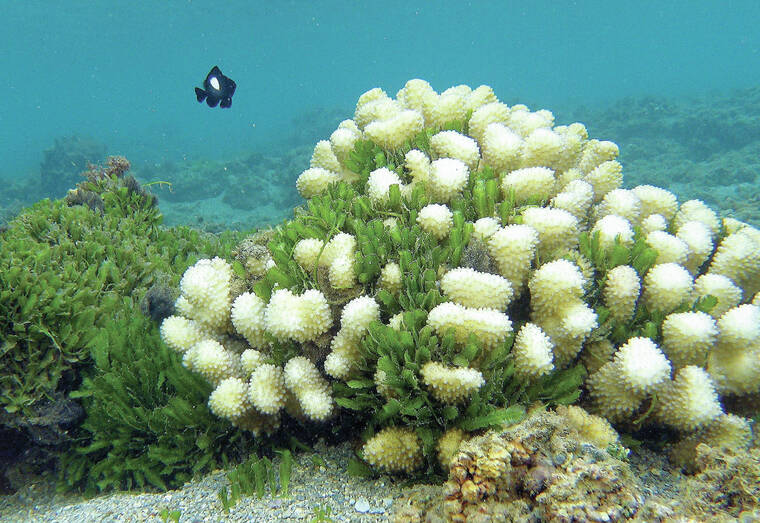There is a massive, ongoing battle for space happening right now on our Hawaiian coral reefs and the battlefield is changing quickly.
Up on land there is an ongoing fight for space along our coastlines between the rising sea levels, disappearing beaches and ocean front homeowners. No one knows who owns what because the coastline is changing quickly. Out on the reef, the same thing is happening and the battle between algae and coral is dramatic.
Kaua‘i and O‘ahu have unique coral reefs because there is a lot of rain flowing off of the land onto the near-shore reefs. Coral does not grow well near a freshwater source and algae does not grow well in the pounding surf.
We have healthy native algae (limu) that grows near the freshwater streams and healthy coral that grows on the reef between the freshwater streams. The algae and coral compete for the parts of the reef where both of them can grow.
Limu is an important food source for people, sea turtles, crabs and many fish species, and the coral is an important food source for butterfly fish and parrot fish. The balance between algae growth and coral growth on our reefs is very important for a healthy Hawaiian coral reef.
One of the major problems happening out on the reefs is the boundary between native algae and coral is constantly changing, so on some of our reefs the algae is taking over and the coral is dying and other parts of the reef the opposite is taking place.
The other major problem is we have nonnative invasive algae also growing on the reef and this creates a huge problem changing the delicate balance between limu and coral growth.
Most coral reefs in the world occur in dry climates or way offshore, so they are not affected by rain runoff. Here in Hawai‘i large plantation farms and development companies have altered our streams and rivers, and this dramatically alters the relationship between healthy limu and healthy coral out on the reef.
This change on the reef can completely alter the entire reef ecosystem and change the habitat where baby fish grow which affects our entire fishing community.
If you build a golf course in Kaua‘i and alter fresh water runoff, you will change the entire reef system in the area. This stresses out the coral and allows nonnative algae to take over a once beautiful coral reef.
Putting a golf course on a bone dry Caribbean Island won’t damage or change the surrounding coral reefs because there are no streams to begin with. Other factors that change the balance between algae and coral growth in Hawai‘i include toxic runoff from farm chemicals, mud runoff from construction projects, sonar and electronics from military ships and submarines, and even too many tourists swimming over and walking on the reef.
Here in Hawai‘i, we have to work much harder to keep a healthy coral reef than in other dry weather climates around the world. We need to look at and monitor just about everything we do on land, as that could affect the health or our coral reefs and marine life for decades to come.
A healthy Hawaiian coral reef is always in a battle for space between our native algae and corals, and when we alter the reefs due to land activities the whole ecosystem can spin out of control.
The more we educate our children about our delicate coral reef system here in Hawai‘i, the better job they can do in managing our marine life in the future. That is why we are so focused on our marine life educational movies we show in our schools that we feature on our website at www.underwater2web.com.
•••
Terry Lilley is a marine biologist living in Hanalei Kaua‘i and co-founder of Reef Guardians Hawai‘i, a nonprofit on a mission to provide education and resources to protect the coral reef. To donate to Reef Guardians Hawaii go to www.reefguardianshawaii.org.


